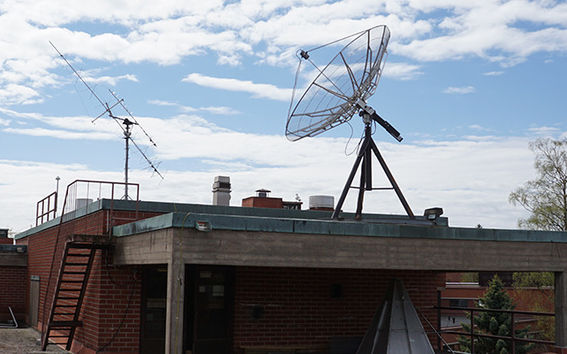The brain of Aalto-1 is built by students

The builders of the first satellite in the Finnish history, Aalto-1, are in an exciting phase. They are currently constructing the final flight model, and soon the students will see the results of their work in action. One of the most important project phases has been the software development of the satellite and the ground station. Without a functional data communications system, the satellite will not be able to send the necessary data to the ground station located in Otaniemi.
A large number of enthusiastic students have participated in the five-year development work.
‘The best thing about this project has been the fact that we have had a possibility and, above all, courage to try out different solutions. Not all of them have been practical, but everyone of us has learnt a great deal during this journey’, says doctoral student Hannu Leppinen.
In the picture: the builders participating in the final stages of data communications system during the summer at Otaniemi ground station. From left to right, beginning from the upper row: Petri Niemelä, Joonas Javanainen, Nuno da Silva, Henrik Forsten, Henry Sanmark and Antti Kestilä.
The laborious data communications system is now nearly finished. The final parts will be finalised during the following weeks. Aalto-1, a CubeSat-based nanosatellite and only slightly larger than a milk carton, contains plenty of state-of-the-art technology. The satellite brain, main computer designed and built by students, will relay all the necessary information from space to Otaniemi ground station.
‘The circuit board called OBC (on-board computer) actually contains two identical Linux-based main computers. In case the first main computer in use encounters an error condition, we can enable another similar one’, describes Leppinen.
During the summer, in addition to the data communications system, the team focussed especially on error condition handing: what kinds of possible error conditions could arise in the main computer brain, and how to deploy the auxiliary system if need be.
‘It is possible to update the software to some extent even when already in space, but we hope that we have to resort to this as little as possible, because it always poses a risk. At the moment everything seems to be in order, though. In a project such as this, everything affects everything, and during the five years, there have been more than a hundred people working on the Aalto-1 project. It would seem we managed to make the package operational’, Leppinen states contentedly.
You can follow the assembly process of the flight model on Twitter twitter.com/aaltoone and on Facebook facebook.com/AaltoSatellites
Aalto-1 is a student satellite project spearheaded by the Department of Radio Science and Engineering of the Aalto University School of Electrical Engineering. Aalto-1 will take important Finnish space expertise into space for testing. A new type of spectrometer device developed by VTT will be used for remote environmental sensing, while a radiation meter built by students from the University of Helsinki and University of Turku will take radiation measurements. Aalto-1 will also test an electrostatic plasma brake for deorbiting satellites that was designed by the Finnish Meteorological Institute.
News: 7 August 2015 Aalto-1 reaching great heights
News: 5 June 2015 Busy summer ahead for students
News: 9 April 2015 Contract signed for Aalto-1 satellite launch
Read more news

Your voice gives away valuable personal information, so how do you keep that data safe?
With speech technologies becoming increasingly common, researchers want to make sure we don’t give away more information than we mean to.
Aalto in 2025: Quantum leaps, creative breakthroughs and solutions for a better life
Growth, technology and industrial renewal; human-centred solutions; health and everyday wellbeing; and enjoyable daily life and thriving communities.
Research Council of Finland establishes a Center of Excellence in Quantum Materials
The Centre, called QMAT, creates new materials to power the quantum technology of coming decades.






